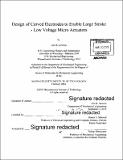| dc.contributor.advisor | Martin A. Schmidt. | en_US |
| dc.contributor.author | Newton, Eric B | en_US |
| dc.contributor.other | Massachusetts Institute of Technology. Department of Mechanical Engineering. | en_US |
| dc.date.accessioned | 2016-08-02T20:08:21Z | |
| dc.date.available | 2016-08-02T20:08:21Z | |
| dc.date.copyright | 2016 | en_US |
| dc.date.issued | 2016 | en_US |
| dc.identifier.uri | http://hdl.handle.net/1721.1/103849 | |
| dc.description | Thesis: Ph. D., Massachusetts Institute of Technology, Department of Mechanical Engineering, 2016. | en_US |
| dc.description | Cataloged from PDF version of thesis. | en_US |
| dc.description | Includes bibliographical references (pages 132-137). | en_US |
| dc.description.abstract | Electrostatic actuators are common in many MicroElectroMechanical Systems (MEMS) devices. These actuators tend to be fabricated as two parallel planar structures, which works well for applications where the motion and electrode spacing are small. To achieve larger displacements, very large voltages are needed. Curved electrodes provide a way to create actuators that achieve large displacements and large forces at much lower voltages than comparable parallel plate designs. This thesis describes two methods for creating curved silicon membranes that can be easily integrated into practical devices. The first method uses air pressure to plastically deform a silicon membrane at high temperature. During wafer bonding, gas is trapped behind a thin silicon membrane. High temperature annealing causes the gas to pressurize, plastically deforming the silicon membrane. A model predicting the extent of plastic deformation was matched with actual deformation measurements. The second method utilizes the strain resulting from curing epoxy. A diaphragm is formed by etching through the handle of an SOI wafer, leaving a circular silicon membrane. After filling the etched hole with epoxy and covering it, the epoxy shrinks and pulls the membrane into a curved shape. These curved membranes have been integrated into electrostatic actuators. Pull-in was demonstrated on devices with a wide range circular membranes. The actuation is reliable and requires relatively low voltages. A first order model based on the principle of virtual work was developed that accurately predicts the onset of pull-in. Predictions are compared for several electrode profiles and in every case the critical voltages were lower than for parallel plates. Finally, the design of a MEMS vacuum pump that incorporates curved electrostatic actuators is analyzed. Factors that affect the base pressure, such as dead volume and pumping volume, are discussed in detail. With low leak rates, base pressures as low as 0.24 Torr could be achieved in these devices in a two stage pump. Guidelines for the design and operation of future MEMS diaphragm pumps are proposed. | en_US |
| dc.description.statementofresponsibility | by Eric B. Newton. | en_US |
| dc.format.extent | 144 pages | en_US |
| dc.language.iso | eng | en_US |
| dc.publisher | Massachusetts Institute of Technology | en_US |
| dc.rights | M.I.T. theses are protected by copyright. They may be viewed from this source for any purpose, but reproduction or distribution in any format is prohibited without written permission. See provided URL for inquiries about permission. | en_US |
| dc.rights.uri | http://dspace.mit.edu/handle/1721.1/7582 | en_US |
| dc.subject | Mechanical Engineering. | en_US |
| dc.title | Design of curved electrodes to enable large stroke -- low voltage micro actuators | en_US |
| dc.type | Thesis | en_US |
| dc.description.degree | Ph. D. | en_US |
| dc.contributor.department | Massachusetts Institute of Technology. Department of Mechanical Engineering | |
| dc.identifier.oclc | 953876626 | en_US |
